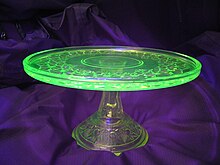Wikipedia:Reference desk/Archives/Science/2022 August 22
| Science desk | ||
|---|---|---|
| < August 21 | << Jul | August | Sep >> | August 23 > |
| Welcome to the Wikipedia Science Reference Desk Archives |
|---|
| The page you are currently viewing is a transcluded archive page. While you can leave answers for any questions shown below, please ask new questions on one of the current reference desk pages. |
August 22[edit]
Can something be radioactive and chemiluminscent?[edit]
Radioactive while undergoing fluorescence and phosphorescence? Or is that the work of science fiction. Heh. 67.165.185.178 (talk) 12:15, 22 August 2022 (UTC).
- See Radioluminescence, paints made from a mixture of radium and a phosphorescing compound were once used in self-illuminating paints, at least until it was realized how toxic the radiation from these paints were. --Jayron32 12:20, 22 August 2022 (UTC)
- I have a pistol whose sights contain tiny vials of phosphor mixed with tritium, whose decay is less frightful than that of radium. —Tamfang (talk) 01:01, 25 August 2022 (UTC)
- Yup, that's a popular use. We actually have a whole article specifically about tritium radioluminescence. DMacks (talk) 00:32, 26 August 2022 (UTC)
- I have a pistol whose sights contain tiny vials of phosphor mixed with tritium, whose decay is less frightful than that of radium. —Tamfang (talk) 01:01, 25 August 2022 (UTC)
- Or if you mean something that has these properties independently (rather than one being involved with the other), a radioactive version of any chemical that is chemilumiscent can be made simply by synthesizing it with an appropriately radioactive isotope of one of its atoms, or radioactive tag attached. DMacks (talk) 18:45, 22 August 2022 (UTC)
- Radioactive tag attached? I think I'm missing something here, are there even radioactive compounds in organic chemistry? 67.165.185.178 (talk) 03:45, 23 August 2022 (UTC).
- All natural organic compounds are radioactive, since they contain 14C, which of course is the basis of carbon-14 dating. Hence it is the rule, rather than the exception that fluorescence or phosphorescence compounds are radioactive, albeit at low levels. Mike Turnbull (talk) 11:00, 23 August 2022 (UTC)
- Radioactive tag attached? I think I'm missing something here, are there even radioactive compounds in organic chemistry? 67.165.185.178 (talk) 03:45, 23 August 2022 (UTC).

- Radiochemistry. Literally a whole field. Fgf10 (talk) 07:14, 23 August 2022 (UTC)
- Chemiluminescence and fluorescence are properties of a molecule. They appear as a result or the structure of a molecule and the configuration of its electrons. That has to do with the positioning and charge of the atomic nuclei, but not with the number and distribution of neutrons. Radioactivity has everything to do with those neutrons. Every element has radioactive isotopes, so you can always take a fluorescent molecule and replace some of its atoms with a radioactive isotope to get something both fluorescent and radioactive. That is, if the radioactive isotope lives long enough that you can make some interesting molecules with it. Most organic molecules contain at least hydrogen or carbon, which will do nicely.
- Radioactivity and fluorescence are independent properties. One doesn't rule out the other, one doesn't imply the other. The only connection is that fluorescent materials may light up in response to nearby radioactive materials. PiusImpavidus (talk) 09:22, 23 August 2022 (UTC)
Okay, so there's 3 main types of radiation decay: alpha, beta, and gamma. I think the rarer type with chemiluminescence is alpha decay? And it seems gamma decay is itself a luminescence if light is already emitted. 67.165.185.178 (talk) 11:39, 23 August 2022 (UTC).
- Gamma radiation and light are the same phenomena, but you can't see gamma radiation. It has much too short of a wavelength for your vision cells to detect it. Your eyes can only detect electromagnetic radiation in the visible range, which is a range of about 400 nm (violet) on the low end, and 700 nm (red) on the high end. Anything of a shorter or longer wavelength than that is not detectable by your eyes. Gamma radiation generally lies in the picometer range or smaller, meaning it is about 1/10,000 the wavelength of visible light. --Jayron32 12:23, 23 August 2022 (UTC)
- Alpha radiators are all very heavy elements. They usually have no interesting chemical properties that you can't get from their neighbours one row up in the periodic table, which are easier to get and safer to use. You'll rarely encounter alpha radiators in any context except where their nuclear physics matters. Organic chemistry, which is where most of the interesting stuff happens, is all about light elements, so no alpha radiators. PiusImpavidus (talk) 08:23, 24 August 2022 (UTC)
